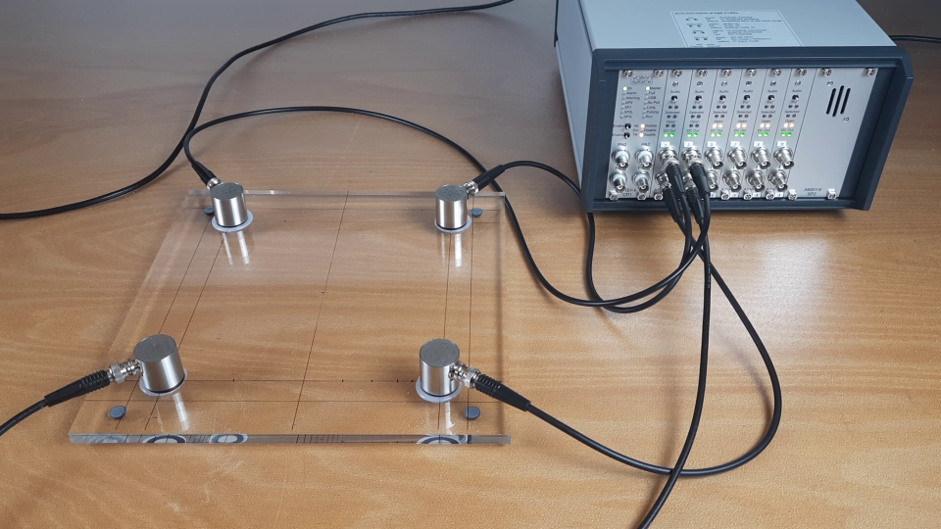PMMA plate with different AE sources
This dataset consists of AE signals generated by different sources on a PMMA plate. It is intended for studying and experimenting with data-based approaches for AE source classification.
The PMMA plate is excited using three distinct AE sources:
- Pencil-lead breaks (Hsu-Nielsen source with 0.5 mm leads)
- Pulsing by the AMSY-6 acoustic emission measurement system with 30 Vpp
- Salt trickling from a salt shaker, positioned approximately 20 cm away

Structure
- Material: Polymethyl methacrylate (PMMA)
- Dimensions: 300 x 300 x 9.7 mm
Measurement chain
- Vallen AMSY-6 AE measurement system with ASIP-2A signal processor cards
- 4x Vallen VS150-RSC sensors with 34 dB preamplifier gain
- Measurement settings:
- Filter: 95-300 kHz
- Threshold: 40 dBAE
- Duration discrimination time: 1000 µs
- TR (transient/raw data):
- Samplerate: 2500 kHz
- Pretrigger samples: 100
- Post-duration samples: 1000
Sensor positions
The sensors are arranged in a square configuration on the PMMA plate:
| Channel | X [mm] | Y [mm] |
|---|---|---|
| 1 | 50 | 50 |
| 2 | 250 | 50 |
| 3 | 50 | 250 |
| 4 | 250 | 250 |
Files
All files can be downloaded here: https://filetransfer.vallen.de/openae/datasets/pmma-plate-sources/.
Each measurement consists of two SQLite3 database files:
*.pridb: The primary database, that stores just the AE features (amplitude, energy, counts, duration, rise time, ...) and the index of the transient/raw dataTRAI. Use the tableview_ae_data.*.tradb: The transient database, that stores the raw data for each hit record referenced by theTRAIindex. Use the tableview_tr_data. The raw data is stored in theDatacolumn in binary format (int16values). The factor from columnTR_mVcan be used to transform the integer values to millivolts.
You may want to use the Python library vallenae to easily read the measurement files.
| Link | Source | Hits |
|---|---|---|
| plbs.pridb plbs.tradb | Pencil-lead breaks | 266 |
| pulse.pridb pulse.tradb | Pulsing | 292 |
| salt.pridb salt.tradb | Salt trickling | 282 |
Examples
- classifier-openae.ipynb: SVM classifier trained with OpenAE features
- classifier-standard.ipynb: SVM classifier trained with standard AE features